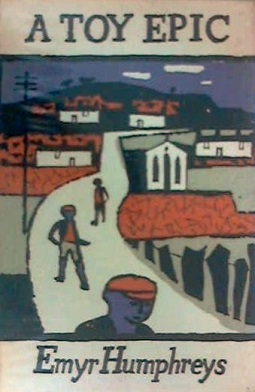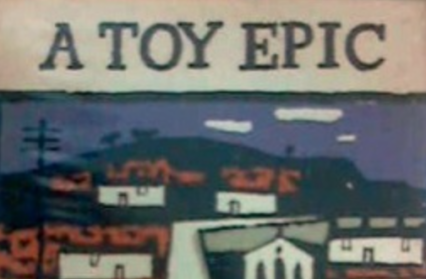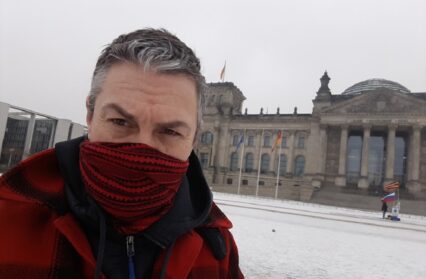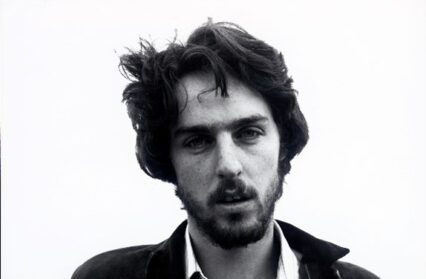Gary Raymond nominated Emyr Humphreys‘ 1958 classic A Toy Epic as the first in our search for the Greatest Welsh Novel, the story of three young boys growing up in Flintshire between the wars.
Perhaps a strange choice for some to open Wales Arts Review’s nominations for The Greatest Welsh Novel, Emyr Humphreys’ A Toy Epic, published in 1958 (although Humphreys started it in 1945), is best described by its somewhat emotionally detached title. It is, in publishing terms, a novella, but in terms of theme and scope it is as far-reaching as any potent national statement, as richly symbolic and thoughtful in its own way as any Dr Zhivago or Grapes of Wrath. It is a story of a country in transition, told through the humble comings of age of Michael, Iorwerth and Albie. It is a story about the end of a world that had lasted longer than folktales, the world of the harrow and shire horse, of chapel and Sunday best. It is the story of the moment when Wales became the Wales we know today, and stopped being the Wales of our nation’s compulsively nostalgic psyche. But most significantly, A Toy Epic is Wales’ most important war novel.
To this last point we will return.
 Firstly, however, let us look at the significance of this book as a piece of literature, published and written, as it was, during what is generally regarded as the dark ages for the modern British novel of 1945-1960.
Firstly, however, let us look at the significance of this book as a piece of literature, published and written, as it was, during what is generally regarded as the dark ages for the modern British novel of 1945-1960.
A Toy Epic is Wales’ shining example of literary modernism. Humphreys, in this book at least, in this period of his writing, is a modernist in the exact sense of the word. He is experimenting with form (albeit in the footsteps of Maddox Ford, Joyce, Faulkner, and Woolf – in particular The Waves which folds an arm around A Toy Epic from beginning to end), but also he is conducting these experiments at the fault lines of fear and exaltation that the early part of the twentieth century inspired in its artists.
Modernists of the time fell pretty much into two categories: those like Eliot and Pound who embraced the new world, albeit warily, the one scarred by the coruscating trenches of the Western Front, embittered by the political chaotics of Imperialism and Fascism as one faded and the other matured. They built literature out of iron and mud and concrete, and painted with palettes of grey. Others like Yeats and Edward Thomas warned against what they saw as the onslaught of modernity and industrialisation. But their work was touched no less by an unbridling of their genius, fed by the same revivifying air that allowed them to experiment. For the novel, modernism meant that rules were now there to broken, affect now had a different, more prominent role in the narrative, and fiction was no longer the sole kingdom of the storyteller. Tolstoy may have given a cameo to a cognisant dog to discuss the roll of nature in nihilism in Anna Karenina, but modernists could go much further and for much longer. A Toy Epic is a marvellous example of modernist techniques employed to condense the reading experience whilst opening up the riches of prose’s potential.
It is an advance in literary ambition from Humphreys’ first attempt at a modernist narrative, A Man’s Estate, in that it looks at the events of the wider world from a three-pronged personal, localised, and largely narrow understanding of the world. The march of the modern world affects everyone, whether they are aware of it or not. A Toy Epic is a novel that explains the world, explains Wales, but does it while never letting go of that ‘innermost flame’ that explores the ‘extraordinary quality of an ordinary mind on an ordinary day’ that Woolf talked about when distancing herself from the superficiality of those novelists she termed ‘materialists’.
Humphreys takes the lessons of The Waves even further. As we spin through the apparent simple coming of age story, gliding from the internal perspectives of the three boys often from paragraph to paragraph, as the story gains pace we are also subjected to subtle but significant shifts in time and space. A conversation at Albie’s parents’ breakfast table, for instance, can take in several years of breakfasts and can be used to display both the growing awareness of Albie, the mild disintegration of his family unit, but also the alterations of public life, to society itself and the very bones of civilisation. This will take up half a page and do the job of seventy from a Victorian novelist.
Humphreys was looking for something pure. He had been influenced heavily by the syntactical tricks of Faulkner in The Sound of the Fury (as well as Woolf’s shifting perspectives in The Waves), which A Toy Epic resembles closely in the details of its most technically daring passages. But he had also been influenced by M.M. Bahktin’s 1937 essay ‘Forms of Time and the Chronotope in the Novel’. Bahktin, borrowing from Einstein, adopts the chronotope as a term to describe a particular type of literature:
In the literary artistic chronotope, spatial and temporal indicators are fused into one carefully thought-out, concrete whole. Time, as it were, thickens, takes on flesh, becomes artistically visible; likewise, space becomes charged and responsive to the movements of time, plot and history. This intersection of axes and fusion of indicators characterises the artistic chronotope.
That Humphreys pondered this idea, this mode of narrative transport, and then took thirteen years to perfect the one hundred and eighty pages of A Toy Epic until its publication, shows a brilliant literary mind chiselling away at some very exacting innovations. So is A Toy Epic even a novel? (Virginia Woolf, after all, called her The Waves a ‘playpoem’, not a novel). If a novel is about the scope of a world within the bindings of a book rather than a word count, it most certainly is.
But Humphreys’ masterpiece is not just about the technical achievements.
It is a very moving story of three boys growing up. It is a story about childhood, and Welsh childhood specifically, and between the wars specifically; it is about church versus chapel, about class, about different types of masculine identity, about prospects, about sex, marriage and definitely about death. It is a book about how a moment of minor madness can change a life forever, and how nurture can get its claws firmly into nature. As M. Wynne Thomas points out in his full and excellent introduction to the Seren edition, the boys are supposed to represent the polarities at work in Wales during the time; the anglicanisation of Wales from without and within, the erosion of tradition, the significant internal migrations of a country experiencing an industrial pattern that was witnessing its communities move closer to the coast.
But A Toy Epic has one extremely powerful central theme, the one I mentioned at the outset, and one which dominates the book and all subsequent themes, and that is war.
The novel is framed by the First and Second World Wars and the shadows of both, one gone and one looming, colour the novel dark. War is the ultimate representation in the book of the modernists’ dilemma: war, although a threat to the very existence of civilisation, can also advance it.
The myth of heroism in war is challenged in the book. A most memorable passage has Michael perusing the photographs in a roll of honour at his school. Michael thinks of them as not only ‘innocent’ but also as ‘pathetic’. The school itself is a mechanism to assert different roles within the masculine hierarchy. Albie is being groomed for the officer class. The doomed young Jac has his future keenly mapped out, mainly because of his aptitude for rule-breaking, but a rule breaking that has a constant alignment with the behaviour associated with the masculinity that leads men to war.
Throughout the book there are allusions to the causes of war, to working class and middle class oppressions – to the treatment of the kulaks to the Easter Rising to the persecution of the Jews in NAZI Germany. Wales becomes linked to such radicalism in the book. A barber snipping at hair mentions how Welsh nationalists should be put up against the wall and shot. Divisions are everywhere, complexities are everywhere; rifts, loggerheads, the masses engulfed in the uncertainty of war.
Fascism, the ugliest and most potent of political fads in the nineteen thirties, felt less surely in Wales than elsewhere in Europe, has a strong presence in the book. And it sinks sagaciously into Humphreys’ powerful ideas about language. There are no Blackshirts in Wales, but there is the pulpit, and Humphreys has no problems linking the rhetoric of religion with the rhetoric of politics, with all of the corruption and the rot, and the ‘whipping up of fervour’. Here Humphreys speaks clearly about his literary attitudes to war. Language fails it – the rhetoric of the pulpit wins out, it sends men to their death, but can never explain why they die, not really. As Jacqueline Rose writes so well, ‘the concept of war is incapable of calculating, or mastering, the chaos, inconsistency, and randomness of the object it is meant to predict and represent.’ And so the novel itself becomes a rich smattering of random events, tragedies and disappointments, of characters trying to come to terms with what life throws at them; some fail and some hold on for dear life. What A Toy Epic states very convincingly is that war is a part of the human condition, not a temporal space that stands opposite to ‘peace time’.
But Humphreys is always primarily concerned with the individual – A Toy Epic is not a cold novel, despite the impression I may have given up until now. Progress of humanity and community aside, the journey from childhood to maturity of the three boys is what drives the story along, is what makes it worth the riches that come interred.
A Toy Epic is a Great novel. It is set in a time and a place, yet transcends these things, bringing the immediate along with it to the everlasting questions of the human condition. And this happens bedded with warm and real characters, whole and fragmented all at once, and always Welsh.
This piece is a part of Wales Arts Review’s ‘Greatest Welsh Novel‘ series.
Gary Raymond is a novelist, critic, editor and broadcaster.



 Enjoyed this article? Support our writers directly by buying them a coffee and clicking this link.
Enjoyed this article? Support our writers directly by buying them a coffee and clicking this link.








